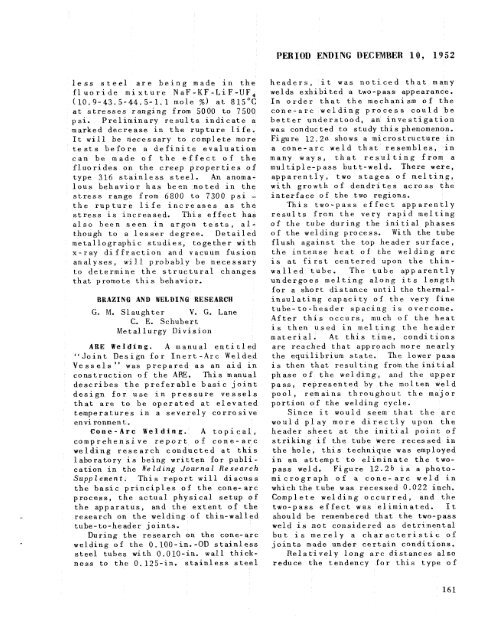the Molten Salt Energy Technologies Web Site
the Molten Salt Energy Technologies Web Site
the Molten Salt Energy Technologies Web Site
You also want an ePaper? Increase the reach of your titles
YUMPU automatically turns print PDFs into web optimized ePapers that Google loves.
less steel are being made in <strong>the</strong><br />
fluoride mixture NaF-KF-LiF-UF,<br />
(10.3-43.5-44.5- 1.1 mole X) at 815°C<br />
at stresses ranging from 5000 to 7500<br />
psi. Preliminary results indicate a<br />
marked decrease in <strong>the</strong> rupture life.<br />
It will be necessary to complete more<br />
tests before a definite evaluation<br />
can be made of <strong>the</strong> effect of <strong>the</strong><br />
fluorides on <strong>the</strong> creep properties of<br />
type 316 stainless steel. An anoma-<br />
lous behavior has been noted in <strong>the</strong><br />
stress range from 6800 to 7300 psi -<br />
<strong>the</strong> rupture life increases as <strong>the</strong><br />
stress is increased. This effect has<br />
also been seen in argon tests, al-<br />
though to a lesser degree. Detailed<br />
metallographic studies, toge<strong>the</strong>r with<br />
x-ray diffraction and vacuum fusion<br />
analyses, will probably be necessary<br />
to determine <strong>the</strong> structural changes<br />
that promote this behavior.<br />
BRAZING AND WELDING RESEARCH<br />
G. M. Slaughter V. G. Lane<br />
C. E. Schubert<br />
Met a1 1 urgy Division<br />
ARE Welding. A manual entitled<br />
“Joint Design for Inert-Arc Welded<br />
Vessels” was prepared as an aid in<br />
construction of <strong>the</strong> ARE. This manual<br />
describes <strong>the</strong> preferable basic joint<br />
design for use in pressure vessels<br />
that are to be operated at elevated<br />
temperatures in a severely corrosive<br />
envi ronmen t .<br />
Cone-Arc Yielding. A topical,<br />
comprehensive report of cone-arc<br />
welding research conducted at this<br />
laboratory is being written for publi-<br />
cation in <strong>the</strong> Pelding Journal Research<br />
Supplement. This report w i l l discuss<br />
<strong>the</strong> basic principles of <strong>the</strong> cone-arc<br />
process, <strong>the</strong> actual physical setup of<br />
<strong>the</strong> apparatus, and <strong>the</strong> extent of <strong>the</strong><br />
research on <strong>the</strong> welding of thin-walled<br />
tube- to- header j oint s.<br />
During <strong>the</strong> research on <strong>the</strong> cone-arc<br />
welding of <strong>the</strong> 0.100-in. -OD stainless<br />
steel tubes with 0.010-in. wall chick-<br />
ness to <strong>the</strong> 0.125-in. stainless steel<br />
PERIOD ENDING DECEMBER 18, 1952<br />
headers, it was noticed that many<br />
welds exhibited a two-pass appearance.<br />
In order that <strong>the</strong> mechanism of <strong>the</strong><br />
cone-arc welding process could be<br />
better understood, an investigation<br />
was conducted to study this phenomenon.<br />
Figure 12.2a shows a microstructure in<br />
a cone-arc weld that resembles, in<br />
many ways, that resulting from a<br />
multiple-pass butt-weld. There were,<br />
apparently, two stages of melting,<br />
with growth of dendrites across <strong>the</strong><br />
interface of <strong>the</strong> two regions.<br />
This two-pass effect apparently<br />
results from <strong>the</strong> very rapid melting<br />
of <strong>the</strong> tube during <strong>the</strong> initial phases<br />
of <strong>the</strong> welding process. With <strong>the</strong> tube<br />
flush against <strong>the</strong> top header surface,<br />
<strong>the</strong> intense heat of <strong>the</strong> welding arc<br />
is at first centered upon <strong>the</strong> thin-<br />
walled tube. The tube apparently<br />
undergoes melting along its length<br />
for a short distance until <strong>the</strong> <strong>the</strong>rmal-<br />
insulating capacity of <strong>the</strong> very fine<br />
tube- to-header spacing is overcome.<br />
After this occurs, much of <strong>the</strong> heat<br />
is <strong>the</strong>n used in melting <strong>the</strong> header<br />
material. At this time, conditions<br />
are reached that approach more nearly<br />
<strong>the</strong> equilibrium state. The lower pass<br />
is <strong>the</strong>n that resulting from <strong>the</strong> initial<br />
phase of <strong>the</strong> welding, and <strong>the</strong> upper<br />
pass, represented by <strong>the</strong> molten weld<br />
pool, remains throughout <strong>the</strong> major<br />
portion of <strong>the</strong> welding cycle.<br />
Since it would seem that <strong>the</strong> arc<br />
would play more directly upon <strong>the</strong><br />
header sheet at <strong>the</strong> initial point of<br />
striking if <strong>the</strong> tube were recessed in<br />
<strong>the</strong> hole this technique was employed<br />
in an attempt to eliminate <strong>the</strong> two-<br />
pass weld. Figure 12.2b is a photo-<br />
micrograph of a cone-arc weld in<br />
which <strong>the</strong> tube was recessed 0.022 inch.<br />
Complete welding occurred, and <strong>the</strong><br />
two-pass effect was eliminated. It<br />
should be remembered that <strong>the</strong> two-pass<br />
weld is not considered as detrimental<br />
but is merely a characteristic of<br />
joints made under certain conditions.<br />
Relatively long arc distances also<br />
reduce <strong>the</strong> tendency for this type of<br />
161



![Review of Molten Salt Reactor Physics Calculations [Disc 2]](https://img.yumpu.com/21979492/1/190x247/review-of-molten-salt-reactor-physics-calculations-disc-2.jpg?quality=85)












